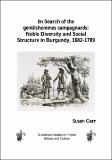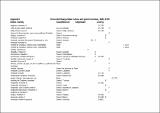Files in this item
In search of the gentilshommes campagnards: noble diversity and social structure in Burgundy, 1682-1789
Item metadata
| dc.contributor.author | Carr, Susan | |
| dc.contributor.editor | Rowlands, Guy | |
| dc.coverage.spatial | 168 | en_US |
| dc.date.accessioned | 2017-07-24T09:27:51Z | |
| dc.date.available | 2017-07-24T09:27:51Z | |
| dc.date.issued | 2017-08-01 | |
| dc.identifier.citation | Carr, Susan. (2017). In search of the gentilshommes campagnards: noble diversity and social structure in Burgundy, 1682-1789. St Andrews Studies in French History and Culture, no. 8. Centre for French History and Culture of the University of St Andrews. | en_US |
| dc.identifier.isbn | 9781907548147 | en_US |
| dc.identifier.isbn | 9781907548154 | en_US |
| dc.identifier.uri | https://hdl.handle.net/10023/11271 | |
| dc.description | Third party material in this work are included in the work's Creative Commons license, unless indicated otherwise in the credit line. The front cover image is (c) Bibliothèque Nationale de France. | en |
| dc.description.abstract | This study of the gentilshommes campagnards of Burgundy reconsiders the supposed decline of the population of old rural noble families during the last century of the ancien régime. Historical debate has focused on various contributing factors in this ‘decline’, such as government centralisation of the seigneurial system, venal ennoblement, noble poverty, and the social and cultural divide between aristocratic elites and minor nobility, old rural military landowning families and newer professional robe nobility. Re-visiting these themes, integrating them with an analysis of official records and surveys of the Burgundian noble population of the period, and looking afresh at notions of noble identity allows this volume to challenge the established view of a noble population and culture in decline. Contemporary sources not only reveal the existence of a sizeable community of gentilshommes, diverse in origins, identities and cultures, but also show that far from fading into provincial obscurity, this community had adapted and evolved, and continued to thrive right up to the eve of the Revolution. | en_US |
| dc.language.iso | en | en_US |
| dc.publisher | Centre for French History and Culture of the University of St Andrews | en_US |
| dc.relation.ispartof | St Andrews Studies in French History and Culture, no. 8 | en_US |
| dc.relation.ispartofseries | St Andrews Studies in French History and Culture | en_US |
| dc.rights | © Susan Carr 2017. | en_US |
| dc.rights.uri | http://creativecommons.org/licenses/by-nc-nd/4.0/ | * |
| dc.subject.lcc | HN438.B88 | en_US |
| dc.subject.lcsh | Nobility -- France -- Burgundy -- History | en_US |
| dc.subject.lcsh | Burgundy (France) -- Rural conditions -- History -- 17th century | en_US |
| dc.subject.lcsh | Burgundy (France) -- Rural conditions -- History -- 18th century | en_US |
| dc.subject.lcsh | Burgundy (France) -- Social conditions | en |
| dc.title | In search of the gentilshommes campagnards: noble diversity and social structure in Burgundy, 1682-1789 | en_US |
| dc.type | Book | en_US |
| dc.description.version | https://doi.org/Publisher PDF | en_US |
| dc.publicationstatus | Published | en_US |
| dc.status | Peer reviewed | en_US |
The following licence files are associated with this item:
This item appears in the following Collection(s)
Items in the St Andrews Research Repository are protected by copyright, with all rights reserved, unless otherwise indicated.



